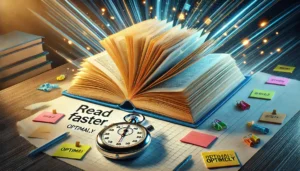x min read

“Mindreading and reading without the mind – Confused?”
Introduction
Reading faster is a skill that if you posses, will set you ahead of the competition. Reading faster will save you time, save your sanity, help you score better academically, and save you sleep.
Every single day, we read. You are reading right now.
Even if you hate reading, we all still read. We read articles, blogs, books, texts, e-mails, movie and video subtitles, and so many other things that the list just never ends.
In many cases, you actually like reading more than you hate it. The only problem is reading stuff that sucks to read. Sure, many of you probably don’t mind reading an article on how A.I. will take over the world, because it’s interesting. But, if you ask me to read 50 pages of a textbook on a historical concept that nobody in a group of 1000 people knows, then reading sucks.
In that situation, how can we make reading easier, faster, and simpler?
A Personal Tip of Mine
Avoid skimming. I know, I know, it might contradict everything your professors and elders have told you, but trust me on this one.
In my experience, skimming never works. After skimming a paragraph or two, I immediately just end up forgetting what I just read. So, I skim it again. And again. And again. The process continues without stop, until I either (a): finally remember what I just read or until (b): I just admit that skimming isn’t going to work.
Skimming will waste so much of your time, so avoid it all costs unless you’re someone who is good at remembering stuff really easily and can store content in your short-term memory as easy as 123.
Tip #1: The “Soft Focus” Technique:
One of the most remarkable yet lesser-known secrets of speed reading is the “soft focus” technique. It challenges the conventional method of rigidly fixating your gaze on each word. Instead, you’ll discover the power of softening your focus while maintaining effective comprehension.
How to apply it:
- Start reading by looking at the center of the text block or page.
- Gradually, allow your peripheral vision to come into play, picking up the words on either side of your central focus.
- Over time, practice expanding your peripheral vision to encompass larger chunks of text, embracing entire phrases or sentences in a single glance.
The “soft focus” technique encourages a fluid, uninterrupted reading flow. By reducing the need for frequent pauses, it enables you to read faster while maintaining a firm grip on comprehension. You’ll find that it minimizes eye strain and the mental fatigue that can come with traditional word-by-word reading.
Of course, this technique takes a lot of practice, and is the opposite of ‘easy to learn’. So, take baby steps and be prepared for the challenges ahead of you. If you are willing to do what it takes to grasp this ability, the time you’ll have left over will thank ya.
Tip #2: The Zigzag Pattern (MOST CHALLENGING)
Conventional reading often follows a linear left-to-right path. However, the zigzag pattern introduces an unconventional approach that can significantly accelerate your reading speed. This technique capitalizes on your brain’s built-in ability to process information in a dynamic, non-linear manner.
How to apply it:
- Begin reading the first line of text in your usual left-to-right fashion.
- As you transition to the next line, start from the right-most side and read leftward.
- Continue this zigzag pattern, alternating directions with each successive line of text.
- Experiment with the pace to find a rhythm that aligns with your reading speed goals.
The zigzag pattern keeps your reading pace brisk and your mind actively engaged. It’s a surprisingly effective way to read faster without feeling rushed or overwhelmed. Over time, this technique becomes more intuitive, allowing you to seamlessly navigate through text with enhanced speed and comprehension.

“What Peripheral Vision would look like”
Tip #3: Peripheral Vision
Your peripheral vision is an untapped resource for reading faster and more efficiently. Many readers tend to focus intently on individual words, which can significantly slow down their overall reading pace. However, by training your peripheral vision, you can absorb larger chunks of text at once.
How to apply it:
- Initiate your practice of peripheral vision expansion by using your fingers or a pen as a guiding tool.
- Place your guiding tool just above the line you’re reading and move it downward to cover a full line of text at a time.
- Gradually train your eyes to capture and comprehend groups of words with each glance.
- As you become more proficient, reduce your reliance on the guiding tool and focus on maintaining peripheral vision expansion independently.
By tapping into the potential of your peripheral vision, you can read text in meaningful chunks, significantly elevating your reading speed without sacrificing understanding. This technique allows your eyes to capture multiple words or even entire phrases at once, contributing to a faster reading experience.
A Personal Tip of Mine #2
When we read, we tend to sound out each and every word in our minds. This takes up precious time and slows the process of absorbing a large chunk of information. So, let’s change that.
Avoid sounding out the words, and try just blatantly reading it without the voice in your head doing it for you. I heard about it online, and I can agree that it’s a great technique for achieving that speed-reading ability that you so very desire.

“Why setting the mind on mute will make you a faster reader than you could imagine”
Action Step
To begin mastering the lesser-known yet highly effective speed reading techniques discussed— the “Soft Focus” Technique, the Zigzag Pattern, and Unleashing the Power of Peripheral Vision—it’s essential to start with deliberate practice. Dedicate a specific reading session to each technique individually.
First, for the “Soft Focus” Technique, select a piece of text, whether it’s an article, a chapter from a book, or any written material of your choice. As you begin reading, focus on maintaining a soft gaze at the center of the text while allowing your peripheral vision to absorb the words on either side. Practice expanding your peripheral vision to encompass larger portions of text as you go.
Next, tackle the Zigzag Pattern in a separate reading session. Follow the instructions closely, starting with your usual left-to-right reading pattern on the first line and zigzagging to the next. Experiment with the pace until you find a rhythm that suits your reading speed goals.
For the final technique, Peripheral Vision, use your guiding tool—whether it’s your finger or a pen. Practice reading with this tool, ensuring that you’re capturing multiple words or phrases with each glance. Gradually reduce your reliance on the tool as your peripheral vision expands, allowing you to read text in meaningful chunks independently.
Conclusion
Hopefully this blog assisted with your speed-reading troubles. I understand if this may have been quite a long one to read, especially considering that you’re here to learn how to read faster, not slower.



